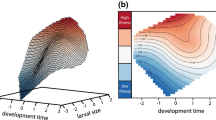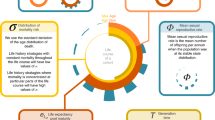Summary
Most evolutionary life history theory is developed in terms of the allocation of resources to the competing ends of growth, reproduction, and survivorship. In this paper we show that certain dimensionless numbers may be used to describe the relationship between growth, maturation, and adult mortality; our theory aims to predict these numbers and we are led to aggregate some basic features of life histories, rather than explicitly considering the allocation of a limited resource to different components of fitness. The phenomenology developed here has the convenient property that only parameters describing the shapes of two assumed trade-offs among life history traits appear in the solution of the resulting optimisation problem. Comparative inter- and intraspecific data on fish, lizard, snake and shrimp populations suggest that this approach may help explain some common patterns in the life histories of animals with indeterminate growth.
Similar content being viewed by others
References
Beverton, R. J. H. (1963) Maturation, growth and mortality of clupeid and engraulid stocks in relation to fishing.Rapp. Proces-Verb. Cons. Intern. Explor. Mer. 154: 44–67.
Beverton, R. J. H. and Holt, S. J. (1959) A review of the lifespans and mortality rates of fish in nature and the relation to growth and other physiological characteristics. InCiba Foundation, Colloquia in ageing. V. The lifespan of animals. pp. 142–77. Churchill, London.
Charnov, E. L. (1991) Non-dimensional numbers in the evolution of life histories.Phil. Trans. Roy. Soc. (Ser. B). In Press.
Charnov, E. L. (1990) On evolution of age of maturity and the adult lifespan.J. Evol. Biol. 3: 139–44.
Charnov, E. L. (1989) Natural selection on age of maturity in shrimp.Evol. Ecol. 3: 236–9.
Charnov, E. L. (1986) Life history evolution in a ‘recruitment population’: why are adult mortality rates constant?Oikos 47: 129–34.
Charnov, E. L. (1979) Natural selection and sex change in Pandalid shrimp: test of a life history theory.Amer. Natur. 113: 715–34.
Charnov, E. L. and Berrigan, D. (1990) Dimensionless numbers and life history evolution: age of maturity versus the adult lifespan.Evol. Ecol. 4: 273–5.
Charnov, E. L. and Shine, R. (1990) Patterns of survivorship, growth and maturation in snakes and lizards. (Submitted, Amer. Natur.).
Cushing, D. H. (1968)Fisheries biology. Univ. Wisconsin Press, Madison, Wisconsin.
Ebert, T. (1975) Growth and mortality in post-larval echinoids.Amer. Zool. 15: 755–75.
Fisher, R. A. (1930)The genetical theory of natural selection. Oxford Univ. Press, Oxford.
Lande, R. (1982) A quantitative genetic theory of life history evolution.Ecology 63: 607–15.
Longhurst, A. R. and Pauly, D. (1987)Ecology of tropical oceans. Academic Press, N.Y.
Moreau, J., Bambino, C. and Pauly, D. (1986) Indices of overall growth performance of 100 Tilapia (Cichlidae) populations. InThe First Asian Fisheries Forum (J. L. Maclean, L. B. Dizon and L. V. Hosillos, eds) pp. 201–6. Asian Fisheries Society, Manila, Philippines.
Munro, J. L. and Pauly, D. (1983) A simple method for comparing the growth of fishes and invertebrates.Fishbyte 1: 5–6.
Pagel, M. D. and Harvey, P. H. (1988) The taxon-level problem in the evolution of mammalian brain size: facts and artifacts.Amer. Natur. 132: 344–59.
Pauly, D. (1978) A preliminary compilation of fish length growth parameters.Ber. Inst. f. Meeresk. Univ. Kiel. No.55, 1–200.
Pauly, D. (1980) On the interrelationships between natural mortality, growth parameters, and mean environmental temperature in 175 fish stocks.J. Cons. Cons. Int. Explor. Mer. 39: 175–92.
Pauly, D. and Munro, J. L. (1984) Once more on the comparison of growth in fish and invertebrates.Fishbyte 2: 21.
Ricker, W. E. (1973) Linear regressions in fishery research.J. Fish. Res. Board Can. 30: 409–34.
Roff, D. A. (1984) The evolution of life history parameters in teleosts.Can. J. Fish. Aquat. Sci. 41: 989–1000.
Roff, D. A. (1986) Predicting body size with life history models.Bioscience 36: 316–23.
Author information
Authors and Affiliations
Rights and permissions
About this article
Cite this article
Charnov, E.L., Berrigan, D. Evolution of life history parameters in animals with indeterminate growth, particularly fish. Evol Ecol 5, 63–68 (1991). https://doi.org/10.1007/BF02285246
Issue Date:
DOI: https://doi.org/10.1007/BF02285246




